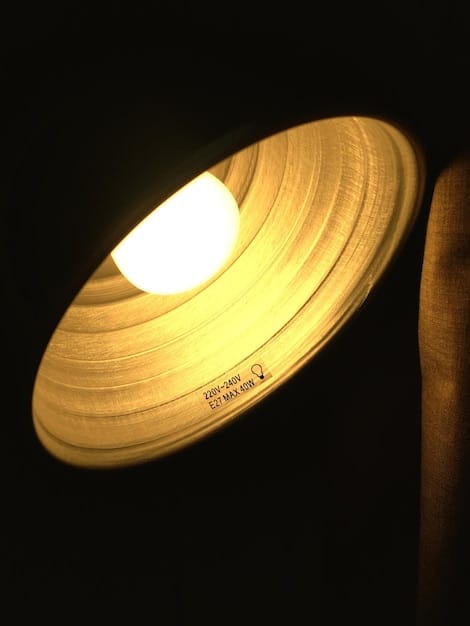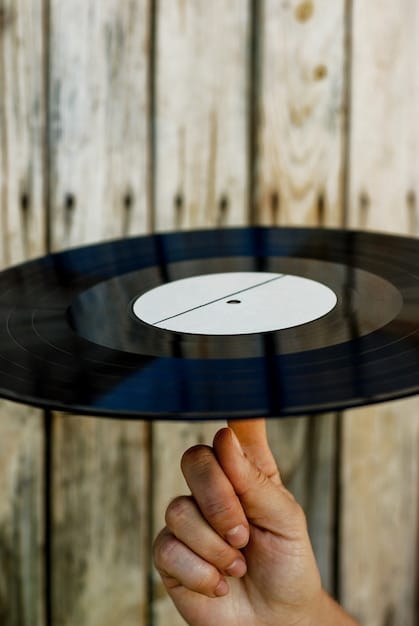The Vinyl Renaissance: Unpacking the Resurgence of Records in the US

The resurgence of vinyl records in the US music scene is fueled by a combination of nostalgic appeal, a desire for a tangible music experience, superior sound quality to streaming for some listeners, and the collectibility and immersive artwork associated with vinyl albums.
The unmistakable crackle as the needle drops, the tactile feel of the album cover – vinyl records are back, baby! But what’s **driving the resurgence of vinyl records in the US music scene** after decades of digital dominance? It’s more than just nostalgia; it’s a complex interplay of factors that’s reshaping how we experience music.
The Nostalgia Factor: Revisiting the Golden Age of Music
At the heart of the vinyl revival lies a powerful wave of nostalgia. For many, vinyl records represent a simpler time, a connection to the music of their youth, and a yearning for an era when music consumption was a more deliberate and engaging experience.
The appeal of vinyl isn’t limited to older generations. Younger listeners are also drawn to the retro aesthetic and the romanticized image of the vinyl era, often discovering classic albums and artists through this medium.
Connecting to the Past
Vinyl records offer a tangible link to music history. Holding an album, reading the liner notes, and carefully placing the needle on the record create a ritualistic experience that transcends simple music playback.
- The tactile experience of handling a record and its artwork.
- The visual appeal of album covers as pieces of art.
- The sense of ownership and connection to a physical artifact.
This connection to the past is a significant driver for many vinyl enthusiasts, offering a counterpoint to the ephemeral nature of digital music consumption. It’s a way to slow down and truly appreciate the artistry and craftsmanship that goes into creating an album.
The Tangible Experience: Beyond the Digital Stream
In a world saturated with digital streams and fleeting online experiences, vinyl offers a refreshing return to the physical. The tangible nature of vinyl records provides a sensory experience that is absent in the digital realm.
From the weight of the record to the smell of the vinyl and the feel of the album cover, every aspect of the vinyl experience contributes to a deeper engagement with the music.

More Than Just Music
Owning a vinyl record is about more than just listening to music; it’s about owning a piece of art, a collectible item, and a conversation starter. The act of collecting, curating, and displaying a vinyl collection becomes a personal expression of taste and identity.
- The joy of discovering rare or unique records.
- The satisfaction of building and showcasing a personal collection.
- The social aspect of sharing music with friends and fellow collectors.
Vinyl represents a conscious choice to engage with music on a deeper level, prioritizing quality and experience over convenience and accessibility. This tangible connection to music fosters a stronger appreciation for the art form.
The Sound Debate: Does Vinyl Really Sound Better?
The question of whether vinyl sounds better than digital audio has been a source of debate among audiophiles for years. While some argue that vinyl offers a warmer, more natural sound, others insist that digital audio provides a more accurate and precise reproduction of the original recording.
Ultimately, the perceived sound quality of vinyl is subjective and depends on various factors, including the quality of the equipment, the mastering of the record, and the listener’s personal preferences.
Analog Warmth vs. Digital Precision
Proponents of vinyl often cite the “analog warmth” as a key advantage. This warmth is attributed to the way analog signals are recorded and reproduced, which can introduce subtle harmonic distortions that are pleasing to the ear.
- The perceived richness and depth of the sound.
- The absence of harshness or digital artifacts.
- The more natural and organic feel of the music.
However, digital audio has its own advantages, including a wider dynamic range, lower noise floor, and greater accuracy in reproducing the original recording. Whether vinyl sounds “better” is a matter of personal preference and the specific listening context.
The Collectible Appeal: Investing in Music History
For many vinyl enthusiasts, collecting records is more than just a hobby; it’s an investment. Rare and limited-edition vinyl records can command significant prices in the collector’s market, making them a potentially lucrative asset.
The value of a vinyl record is determined by factors such as its rarity, condition, pressing history, and the artist’s popularity. Certain albums, particularly those with limited pressings or unique features, can become highly sought-after collectibles.

Beyond Monetary Value
While the potential for financial gain is a factor for some collectors, the true appeal of collecting vinyl lies in the passion for music and the desire to own a piece of music history. Building a collection is a way to connect with artists, genres, and eras that resonate with personal tastes and memories.
- The thrill of the hunt for rare or elusive records.
- The sense of accomplishment in building a comprehensive collection.
- The joy of sharing discoveries with fellow collectors.
The collectibility of vinyl adds another layer of depth to the experience, transforming music consumption into a more active and engaging pursuit.
The Immersive Artwork: A Visual and Auditory Experience
Unlike the tiny thumbnails of digital albums, vinyl records offer large-format artwork that enhances the overall listening experience. The album cover becomes a canvas for visual storytelling, complementing the music within.
Artists and designers often put significant effort into creating visually stunning album covers that capture the essence of the music. These covers can be iconic works of art in their own right, contributing to the cultural significance of the album.
More Than Meets the Eye
The immersive artwork of vinyl records provides a deeper connection to the music, allowing listeners to fully appreciate the artistry and creativity that goes into creating a complete album experience. The visual element adds another layer of enjoyment and engagement.
- The ability to appreciate the details and nuances of the artwork.
- The sense of immersion in the artist’s vision.
- The opportunity to display and share the artwork with others.
This combination of visual and auditory stimulation makes the vinyl experience a uniquely satisfying and engaging form of music consumption.
The Impact of Record Store Culture
The resurgence of vinyl has also fueled a revival of record store culture. Independent record stores are becoming increasingly popular gathering places for music lovers, offering a curated selection of vinyl records, knowledgeable staff, and a sense of community.
These stores provide a welcoming environment for discovering new music, connecting with fellow enthusiasts, and experiencing the joy of browsing through racks of vinyl.
A Hub for Music Lovers
Record stores play a vital role in the vinyl ecosystem, providing a physical space for music lovers to come together, share their passion, and support independent artists and labels. These stores represent a counterpoint to the impersonal nature of online music retailers.
- The opportunity to discover new music through browsing and recommendations.
- The chance to connect with other music lovers and collectors.
- The support for independent artists and labels.
The thriving record store culture is a testament to the enduring appeal of vinyl and the importance of community in the music world. They provide experiences that the digital realm will never be able to replicate, and foster an environment for music exploration.
| Key Point | Brief Description |
|---|---|
| 🎵 Nostalgia | Vinyl evokes memories and a connection to past eras of music. |
| ✋ Tangible Experience | Offers a physical interaction that’s absent in digital formats. |
| 🖼️ Immersive Artwork | Large format artwork enhances the listening experience. |
| 💰 Collectibility | Rare records can be valuable, appealing to collectors. |
Frequently Asked Questions
▼
Vinyl’s resurgence is largely due to a desire for a tangible music experience, a sense of nostalgia, and the collectibility and aesthetic appeal of vinyl albums. The sound quality, though debated, is also a plus for some listeners.
▼
Sound quality is subjective. Some prefer the “warmth” of vinyl, while others find digital to be more accurate. The equipment and mastering both play significant roles in the final audio experience.
▼
Rarity, condition, pressing history, and artist popularity determine collectibility. Limited edition or unique pressings often command higher prices in the collector’s market.
▼
Record stores provide a community hub for music lovers, offering a curated selection and knowledgeable staff. This supports independent artists and fosters a deeper appreciation for music.
▼
Collecting vinyl can range from moderately priced to very expensive, depending on the rarity and condition of the records. Building a quality setup further adds to the overall cost.
Conclusion
The resurgence of vinyl records in the US music scene isn’t just a fleeting trend. It’s a deeper cultural shift driven by a desire for tangible experiences, nostalgia, and a renewed appreciation for the artistry and community surrounding music. Whether it’s the warmth of the sound, the immersive artwork, or the joy of collecting, vinyl is offering a richer and more engaging way to connect with the music we love.





